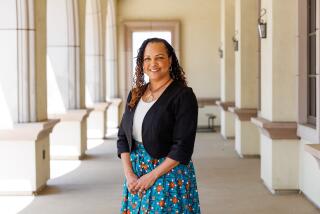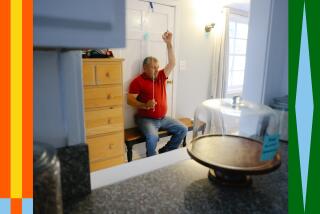Students Barely Speak English : Blind Teacher Discovers Challenge in Classroom
- Share via
BROKEN ARROW, Okla. — Rhanda Hasley’s slender fingers glide over the raised words as she reads to the class.
The students listen carefully, trying to comprehend each word’s meaning and understand its pronunciation.
Hasley has been blind since birth. Her students--who come from Norway, Korea and Venezuela--barely speak English.
Two nights a week in a Broken Arrow classroom, the students and their teacher work to overcome the handicaps.
“They want to learn and I want to teach them. That can overcome anything,” Hasley said.
Hasley teaches “English as a Second Language” at South Intermediate High School. She also teaches a French class. The classes are offered free to residents of the Broken Arrow School District through the district’s Community Education Program.
Three Languages
Hasley’s English students--Hwacha Battenfield of Korea, Norys Crowthen of Venezuela and Anne Marit Auke and her three children of Norway--speak three different languages.
Hasley says the class is challenging because she does not know Korean or Norwegian and the class includes both children and adults who are on various levels.
“I like it, though,” she said. “I really love the people I’m working with; they’re just so eager to learn.”
This is Hasley’s first teaching job since earning her master’s in English as a Second Language education from Oklahoma State University last year.
The 28-year-old Tulsan earned her bachelor’s degree in music education and maintained a 3.7 grade-point average throughout her college career. She went to high school at the Oklahoma School for the Blind in Muskogee.
Difficult Task
Keith Kashwer, director of Broken Arrow Public Schools’ Community Education, said Hasley had been a success in the classroom. But, Hasley said, teaching English as a second language is difficult at times.
“You speak to them slowly; you use pictures whenever possible,” she said. “You just listen and repeat.”
She reads a sentence and each student reads it back, slowly and awkwardly. She patiently listens, encourages and corrects them. Hasley plays her autoharp and teaches her students songs to help them learn the language and the culture.
“There’s something about music,” she said. “I think it helps people to relax. Music is a universal language.”
On the first day of class, Hasley said she had told her students: “Hey, look, there’s one thing I have to tell you--I can’t see. Instead of raising your hand, you’ll have to tell me your name at first until I learn your voice.
“The average blind person can do the same essentially” in the classroom as a sighted teacher, “except using different methods,” she said.
Friends and family help her grade the students’ papers by reading them to her. Her mother reads pages from the textbook into a tape recorder so Hasley can type them on a Braille typewriter. She says Braille textbooks and tapes usually are available.
Hasley said that when she faced a problem, she simply made the best of it. One night when the pages of a photocopied handout got mixed up and the class was not following her, she sensed something was wrong, but she didn’t know what was going on at first.
“We laughed about that,” she said. And then she used the experience to teach her students the meaning of the phrase: “There’s no use crying over spilled milk.”
More to Read
Sign up for Essential California
The most important California stories and recommendations in your inbox every morning.
You may occasionally receive promotional content from the Los Angeles Times.













